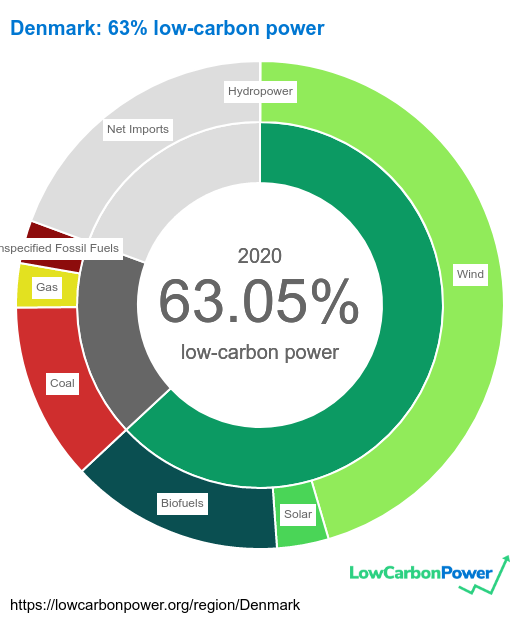Misleading claims about renewable power generation share in Denmark
Misleading claims about renewable power generation share in Denmark
A recent press release from GlobalData claims that, in Denmark, “the share of renewables in the generation mix is already quite high, at 86.4% as of 2020, and it is set to grow to 99.9% in 2030”. For decarbonization enthusiasts like me, this would be great news. Unfortunately, it’s both incorrect and misleading.
It’s incorrect, because even using the same method that GlobalData claims to have used, the share of renewables in 2020 comes out to be 79.4% of the total. More on that further down. The more updated data that we use on this site (for 2020, this data comes from Ember) adds up to 78.2%.
More importantly, it’s misleading because these numbers do not include net imports. Denmark imports almost 20% of its electricity. Taking this into account, domestic renewable electricity generation accounts for only 63% of the total consumption.

What does this mean for predictions of 2030? It is possible that 99.9% of the electricity generated in Denmark will be from renewable energy sources, most of it wind power. But if that is the case, how much of Denmarks electricity will have to be imported? Presumably even more than now. Will the neighboring countries have enough electricity to share? And how clean will this electricity be?
Most importantly, with its reliance on imports, Denmark is a questionable model for others to follow. Countries that import a large share of their electricity tend to be small, like Luxembourg and Lithuania, who get supplied by larger neighbors. If, say, Germany or India wanted to emulate Denmark, it’s unlikely that neighboring countries would be able or willing to provide as much electricity as they would need.
Of the 16 countries that already get 90% or more of their electricity from low-carbon sources, all of them use hydropower and/or nuclear energy. Denmark is attempting to decarbonize without either. So far, it has not proved that to be possible.
The full GlobalData report costs USD $2,500 and I have not had access to it. But GlobalData responded by email clarifying how they got to 86.4%:
Renewables accounting for a share of over 86% in Denmark's power generation mix is based on net electricity generated in the country. It does not include imports.
The data for total generation, wind, solar and hydropower generation is sourced from Danish Energy Agency (DEA). Generation from sources such as thermal and biopower are based on data from International Energy Agency (IEA).
Based on data from DEA, wind and solar PV combined accounted for around 63.5% share of the total electricity generation in 2020. Considering contribution of biopower, the total share of renewables accounted for over 86% in Denmark in 2020. Biopower contributed to around 21-22% of the total electricity generation in the last three years (2017-2019).
The DEA data is available here:
I downloaded the Electricity Supply spreadsheet, and got the 2020 numbers from the “summary tab”:
Net Production: 28 273 GWh
Wind Turbines: 16 150 GWh
Hydropower: 16 Gwh
Solar Photovoltaic: 1 181 GWh
The share of wind, hydro and solar (not taking imports into account) is thus:
(16150 + 16 + 1181) / 28273 = 61.36%
Presumably because the DEA data does not specify numbers for biofuels, GlobalData used data from the IEA to get these numbers. These were last updated in 2019.
Biofuels: 5 094 GWh
5094 / 28273 = 18.02%
The total of renewables, trying to follow the method that GlobalData used, should thus be:
(16150 + 16 + 1181 + 5094) / 28273 = 79.37%
I have asked GlobalData to explain why their results are different but at the current time they have not yet responded. If they do, I will update this story.












